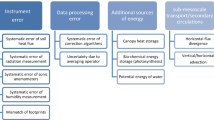Abstract
The main advantages of constant potential enthalpy as a vertical coordinate are weaker horizontal velocity gradients in frontal regions and a higher vertical resolution. A disadvantage is the intersection of isentropes with the ground and folding of these surfaces. A numerical model is proposed to overcome the difficulties imposed by the intersection of isentropes with the ground. The model contains a physical and computational domain. The top and bottom surfaces of the computational domain are isentropes whereas the physical domain of the flow confined above by a free surface of constant pressure, and the bottom of this domain is the surface of the earth. In the present study the top surfaces of these two domains coincide (θ T, PTare constants in space and time). The model was tested for the study of frontogenesis and cyclogenesis and integrated for 7 days. The results correspond to enstrophy-conserving finite difference scheme.
Similar content being viewed by others
Abbreviations
- Cp :
-
specific heat at constant pressure = 1004
- f:
-
Coriolis parameter
- g:
-
gravity
- M:
-
Montgomery potential
- NL:
-
No. of layers
- P:
-
pressure
- Pg :
-
surface pressure = 1000 mb
- q:
-
a variable
- R:
-
gas constant = 287.0
- T:
-
temperature in °K
- u:
-
zonal velocity
- U:
-
mass flux inX-direction
- v:
-
meridional velocity
- V:
-
mass flux inY-direction
- XM:
-
length of the channel = 4800 km
- YM:
-
width of the channel = 3200 km
- Z:
-
potential vorticity
- β:
-
beta-parameter (df/dy) =1.16 × 10−11 m−1 s−1
- ΔPg:
-
5 mb
- Δx:
-
Δy = 200 km
- Δt:
-
480 s
- Δθg :
-
1200 m2 s−2
- ϕ:
-
geopotential (=gz)
- ζ:
-
relative vorticity
- κ:
-
R/CP
- π:
-
Exner function
- θ:
-
potential enthalpy
- θg :
-
potential enthalpy at the ground = 288C p/πgm2 s−2
References
Benjamin S G 1989 An isentropic meso α-scale analysis system and its sensitivity to aircraft and surface observations;Mon. Weath. Rev. 117 1586–1603
Bleck R 1975 An economical approach to the use of wind data in the optimum interpolation of geo- and Montgomery potential fields;Mon. Weath. Rev. 103 807–816
Bleck R 1978 On the use of hybrid vertical coordinate in numerical weather prediction models;Mon. Weath. Rev. 106 1233–1244
Bleck R and Shapiro M A 1976 Simulation and numerical weather prediction framed in isentropic coordinates;Weather forecasting and weather forecasts; Models, systems, and users, Vol. 1, NCAR colloquium, NCAR, pp. 154–168
Brankovic C 1981 A transformed isentropic coordinate and its use in an atmospheric model;Mon. Weath. Rev. 109 2029–2039
Davean D G 1976 A solution for boundary problems in isentropic coordinate models;J. Atmos. Sci. 33 1702–1713
Eliassen A and Raustein E 1968 A numerical integration experiment with a model atmosphere based on isentropic coordinates;Meteor. Annaler. 5 45–63
Eliassen A and Raustein E 1970 A numerical integration experiment with a six level atmospheric model with isentropic information surface;Meteor. Annaler. 5 429–449
Kasahara A 1974 Various vertical coordinate systems used for numerical weather prediction;Mon. Weath. Rev. 102 509–522
Rossby C G 1937 Isentropic analysis;Bull. Am. Meteor. Soc. 18 201–209
Sadourny R 1975 The dynamics of finite-difference models of the shallow-water equations;J. Atmos. Sci. 32 680–689
Sadourny R 1979 Conservation laws, quasi two-dimensional turbulence and numerical modelling of large scale flows;Dynamic meteorology and numerical weather prediction (Reader. UK: European Centre for Medium Range Weather Forecasts Seminar) Vol. 2
Shapiro M A 1975 Simulation of upper-level frontogenesis with a 20-level isentropic coordinate primitive equation model;Mon. Weath. Rev. 103 591–604
Shapiro M A and Hastings J T 1973 Objective cross-section analysis by Hermite polynomial interpolation on isentropic surfaces;J. Appl. Meteor. 12 753–762
Trevisan A 1976 Numerical experiments on the influence of orography on cyclone formation with an isentropic primitive equation model;J. Atmos. Sci. 33 768–780
Uccelini L W, Johnson D R and Schlesinger R E 1979 An isentropic and sigma coordinate hybrid numerical model: Model development and some initial tests;J. Atmos. Sci. 36 390–414
Author information
Authors and Affiliations
Rights and permissions
About this article
Cite this article
Upadhyaya, H.C., Sadourny, R. On the problem of boundary conditions in isentropic coordinates. Proc. Indian Acad. Sci. (Earth Planet Sci.) 101, 35–46 (1992). https://doi.org/10.1007/BF02839171
Received:
Revised:
Issue Date:
DOI: https://doi.org/10.1007/BF02839171




